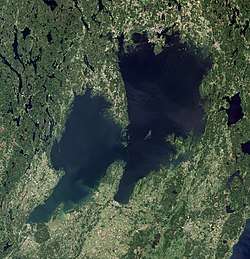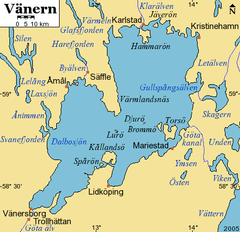Vänern
Vänern (/ˈveɪnərn/ VAYN-ərn, also US: /ˈvɛn-/ VEN-,[2][3][4][5] Swedish: [ˈvɛ̂ːnɛɳ])[6] is the largest lake in Sweden, the largest lake in the European Union and the third-largest lake entirely in Europe after Ladoga and Onega in Russia. It is located in the provinces of Västergötland, Dalsland, and Värmland in the southwest of the country.
| Vänern | |
|---|---|
 Satellite image | |
 Detail map of the lake with surroundings | |
| Coordinates | 58°55′N 13°30′E |
| Primary inflows | Klarälven |
| Primary outflows | Göta älv |
| Basin countries | Sweden |
| Surface area | 5,650 km2 (2,180 sq mi)[1] |
| Average depth | 27 m (89 ft)[1] |
| Max. depth | 106 m (348 ft)[1] |
| Water volume | 153 km3 (124,000,000 acre⋅ft)[1] |
| Surface elevation | 44 m (144 ft)[1] |
| Islands | Brommö, Djurö, Fågelö, Hammarö, Kållandsö, Lurö |
| References | [1] |


History
Geologically, the lake was formed after the Quaternary glaciation about 10,000 years ago; when the ice melted, the entire width of Sweden was covered in water, creating a strait between Kattegat and the Gulf of Bothnia. Due to the fact that ensuing post-glacial rebound surpassed concurrent sea-level rise, lake Vänern became a part of the Ancylus Lake that occupied the Baltic basin.[7] Vänern was connected to Ancylus Lake by a strait at Degerfors, Närke. Further uplift made lakes such as Vänern and Vättern become cut off from the Baltic.[7] As a result, there are still species remaining from the ice age not normally encountered in freshwater lakes, such as the amphipod Monoporeia affinis. A Viking ship was found on the lake's bottom on May 6, 2009.[8]
A story told by the 13th-century Icelandic mythographer Snorri Sturluson in his Prose Edda about the origin of Mälaren was probably originally about Vänern: the Swedish king Gylfi promised a woman, Gefjon, as much land as four oxen could plough in a day and a night, but she used oxen from the land of the giants, and moreover uprooted the land and dragged it into the sea, where it became the island of Zealand. The Prose Edda says that 'the inlets in the lake correspond to the headlands in Zealand';[9] since this is much more true of Vänern, the myth was probably originally about Vänern, not Mälaren.[10]
The Battle on the Ice of Lake Vänern was a 6th century battle recorded in the Norse sagas and referred to in the Old English epic Beowulf. In Beowulf, Vänern is stated to be near the location of the dragon's mound at Earnaness.[11]
Geography
Vänern covers an area of 5,655 km2 (2,183 sq mi). Its surface is 44 m (144 ft) above sea level and it is on average 27 m (89 ft) deep. The maximum depth of the lake is 106 m (348 ft).[12] The water level of the lake is regulated by the Vargön Hydroelectric Power Station [13].
Geographically, it is situated on the border between the Swedish regions of Götaland and Svealand, divided between several Swedish provinces: The western body of water is known as the Dalbosjön, with its main part belonging to Dalsland; the eastern body is known as Värmlandsjön, its northern part belonging to Värmland and the southern to Västergötland.
Its main tributary is Klarälven, which flows into the lake near the city of Karlstad, on the northern shore. Other tributaries include Gullspångsälven, Byälven and Norsälven. It is drained to the south-west by Göta älv, which forms part of the Göta Canal waterway, to Lake Viken into Lake Vättern, southeast across Sweden.
The economic opportunities Vänern offers are illustrated by the surrounding towns, which have supported themselves for centuries by fishing and allowing easy transportation to other cities or west by Göta älv to the sea of Kattegat. This directly includes: Karlstad (chartered in 1584), Kristinehamn (1642), Mariestad (1583), Lidköping (1446) Vänersborg (1644), Åmål (1643), Säffle (1951), and indirectly Trollhättan (1916).
The Djurö archipelago surrounds the island of Djurö, in the middle of the lake, and has been given national park status as Djurö National Park.
The ridge (plateau mountain) Kinnekulle is a popular tourist attraction near the south-eastern shore of Vänern. It has the best view over the lake (about 270 metres (890 ft) above the lake level). Another nearby mountain is Halleberg.
Environment
Environmental monitoring studies are conducted annually. In a 2002 report, the data showed no marked decrease in overall water quality, but a slight decrease in visibility due to an increase of algae. An increasing level of nitrogen had been problematic during the 1970s through 1990s, but is now being regulated and is at a steady level.
Some bays also have problems with eutrophication and have become overgrown with algae and plant plankton.
Fish
Vänern has many different fish species. Locals and government officials try to enforce fishing preservation projects, due to threats to the fish habitat. These threats include water cultivation in the tributaries, pollution and the M74 syndrome. Sport fishing in Vänern is free and unregulated, both from the shore and from boats (with some restrictions, e.g. a maximum of three salmon or trout per person per day). Commercial fishing requires permission.
In the open waters of Vänern, the most common fish is the smelt (Osmerus eperlanus), dominating in the eastern Dalbosjön, where the average is 2,600 smelt per hectare. The second most common is the vendace (Coregonus albula), also most prominently in Dalbosjön, with 200–300 fish per hectare. The populations may vary greatly between years, depending on temperature, water level and quality.
Salmon
Vänern has two sub-groups of land-locked Atlantic salmon (Salmo salar) known as Vänern salmon. They are native to Vänern and spawn in the adjacent lakes. The first sub-group is named after the eastern tributary Gullspångsälven as the Gullspång salmon. The second is the Klarälv salmon, mainly spawning in the Klarälven. These sub-groups are closely related to Atlantic salmon of the Baltic Sea, and they have developed in Vänern for over 9,000 years. They are notable in that they have never entered the ocean.
These large lake salmon are known to weigh some 18 kg (40 lb). The world's largest lake salmon, exceeding 20 kg (44 lb), was caught in Vänern. There are also other species of salmonids in the connecting rivers.
Other fish
The most important large fish in the lake are brown trout (Salmo trutta) and zander (Sander lucioperca). The most important small fish is the stickleback.
Vänern has five distinguished species of whitefish:
- Coregonus pallasii (also common in Neva, Gulf of Finland, Baltic Sea)
- Lacustrine fluvial whitefish (Coregonus megalops)
- Coregonus maxillaris (population mainly known around Sweden)[14]
- Coregonus nilssoni
- Valaam whitefish (Coregonus widegreni)
- Coregonus maxillaris
Birds
The most common birds near Vänern are terns and gulls.
Great cormorants have returned and are flourishing. This has contributed to the increase in the population of white-tailed sea eagles, who feed on cormorants.
See also
- Lakes of Sweden
References
- Seppälä, Matti, ed. (2005), The Physical Geography of Fennoscandia, Oxford University Press, p. 145, ISBN 978-0-19-924590-1
- "Vänern". The American Heritage Dictionary of the English Language (5th ed.). Boston: Houghton Mifflin Harcourt. Retrieved April 14, 2019.
- "Vänern". Collins English Dictionary. HarperCollins. Retrieved April 14, 2019.
- "Vänern" (US) and "Vänern". Oxford Dictionaries UK Dictionary. Oxford University Press. Retrieved April 14, 2019.
- "Vänern". Merriam-Webster Dictionary. Retrieved April 14, 2019.
- Jöran Sahlgren; Gösta Bergman (1979). Svenska ortnamn med uttalsuppgifter (in Swedish). p. 28.
- Björck, Svante (1995). "A review of the history of the Baltic Sea, 13.0-8.0 ka BP". Quaternary International. 17: 19–40. doi:10.1016/1040-6182(94)00057-C.
- "'Viking ship' discovered in Sweden's largest lake". www.thelocal.se. 2009-05-08. Retrieved 2019-02-06.
- Anthony Faulkes (ed. and trans), Snorri Sturluson: Edda (London: Everyman, 1987), p. 7.
- Heimir Pálsson, 'Tertium vero datur: A study of the text of DG 11 4to', p. 44 http://urn.kb.se/resolve?urn=urn:nbn:se:uu:diva-126249.
- Howell D. Chickering, Jr. (ed. and trans), Beowulf (New York: Anchor Books, 2006), lines 3030-3032.
- "World Lakes Database". Archived from the original on 2005-08-02. Retrieved 2006-04-22.
- "Våra kraftverk: Vargön - Vattenfall". powerplants.vattenfall.com (in Swedish).
- Fishbase
External links
| Wikimedia Commons has media related to Vänern. |
| Wikisource has the text of the 1911 Encyclopædia Britannica article Vener. |